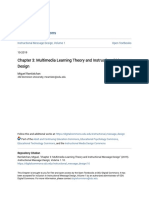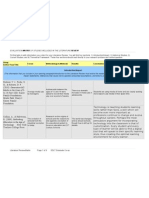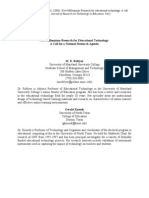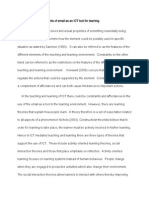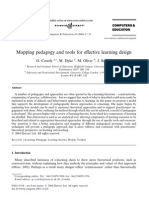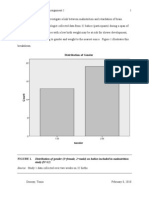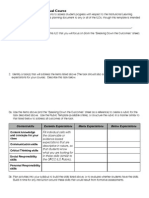Doctoral Research Ideas
Doctoral Research Ideas
Uploaded by
Tonia DousayCopyright:
Available Formats
Doctoral Research Ideas
Doctoral Research Ideas
Uploaded by
Tonia DousayCopyright
Available Formats
Share this document
Did you find this document useful?
Is this content inappropriate?
Copyright:
Available Formats
Doctoral Research Ideas
Doctoral Research Ideas
Uploaded by
Tonia DousayCopyright:
Available Formats
Doctoral Research Ideas
Tonia A. Dousay
University of Georgia
March 23, 2010
Doctoral Research Ideas 2
Introduction
Based upon decades of research regarding cognition, learning, multimedia design, and related
elements, the Cognitive Theory of Multimedia Learning (CTML) provides a framework that aims to
maximize optimal learning potential in multimedia environments. By its very basic definition,
multimedia is the presentation of words and pictures together. Multimedia learning, therefore,
encompasses building mental representations from words and pictures, and multimedia instruction
includes that which presents words and pictures intended to promote learning. Considering research
foundations that tell us there are separate channels for processing visual and auditory information (Pavio
1986; Baddeley 1986, 1999) and that humans are limited in the amount of information that can be
processed by each channel at one time (Baddeley 1986; Chandler & Sweller 1991), Wittrock (1989) and
Mayer (2001) propose that humans engage in active learning by attending to relevant incoming
information, organizing selected information into coherent mental representations, and integrating
mental representations with previous knowledge to be stored in long-term memory. Figure 1 provides an
illustrated overview of this process.
Figure 1. An overview of the process proposed by the Cognitive Theory of Multimedia Learning
Building upon the CTML process, Schnotz (2005) presents an integrated model of text and
picture comprehension (ITPC) that promotes six key principles for consideration in multimedia design.
First, designers should combine text with content-related images only when learners have low prior
Dousay, Tonia A March 16, 2010
Doctoral Research Ideas 3
knowledge and possess sufficient cognitive abilities to process both the text and pictures. This is known
as the basic multimedia principle. Second, the spatial contiguity principle recommends presenting
written text in close spatial proximity to related images. The temporal contiguity principle takes this
concept a step further and suggests presenting spoken text in close temporal proximity to related images.
When using animation, the modality principle proposes the use of spoken words instead of written text.
Related to this, the specific redundancy principle clearly states that written text should not duplicate
spoken words. Lastly, the coherence principle advises against the use of extraneous words and pictures or
unnecessary sound or music. Combined, these principles represent an arsenal of tools to be used by
instructional and multimedia designers to capitalize on learners’ cognitive capabilities to receive and
process knowledge.
Diverse audiences, limiting budgets, constraining timelines, and demanding clients add to the
pressure on designers and instructional project managers. A possible compromise between these factors
might be to place emphasis on specific design principles of the CTML/ITPC. There is compelling evidence
that suggests a negative relationship between interest and satisfaction with multimedia courses (Salomon
1984). This finding has been replicated numerous times with different media (Clark 2001). With respect
to motivation and metacognition, the impact of interest and goal orientation remains active areas of
research for educational psychology. Tobias (2006) has noted that research is beginning to explore the
effect of motivation on metacognition. We know that when students attempt to complete a course within
traditional constructs, they are either interested in the content, motivated to attain a goal of importance,
or both. Incorporating these variables into multimedia and cognitive load theories will become an
important task if instruction is to remain relevant to real-world learning experiences (Fletcher & Tobias
2005). Thus, it would be worthwhile to study the effects of the CTML principles on metacognition and
motivation.
Rationale
As research in educational psychology continues to adapt to the ever-growing field of
instructional technology, it is important that new studies provide practical application. Conceptually,
research that focuses on learner motivation has the potential to impact course and lesson design. First,
consider that online learning is often dominated by multimedia instruction. Then consider that it has
Dousay, Tonia A March 16, 2010
Doctoral Research Ideas 4
been documented that this type of training often runs into challenges with learner motivation and
completion rates (Carr, 2000; Wojciechowski & Palmer, 2005), this presents an overlap between the two
areas that holds a potential resource for practical application in course design. Theoretically, CTML
principles are constantly under scrutiny. As new development tools become available, it cannot be
assumed that the principles are static. Furthermore, as new research seeks to investigate or challenge the
principles, there remains a gap in studying the effects on metacognition and learner motivation.
Importance
As Keller (2008) points out, even though general principles of motivation and learning apply to
all learning environments, there are characteristic problems in a given setting requiring analysis and
design to create motivational and learning practices that exemplify those principles. As Keller’s
comments include the concepts of analysis and design, it should not be overlooked that basic instructional
design practices also promote these two processes. Considering the design constraints previously
mentioned, it is conceivable that conducting an analysis may not be feasible. Good design principles can
help mitigate potential user issues, including motivation. Instructional designers sometimes struggle to
meet stakeholder demands while still attempting to design for the learner. The author’s own experience
as an instructional designer has reinforced these considerations and provided inspiration to seek out
theories that could be further researched and put into practice. If designers are equipped with a set of
best practices including techniques that are proven to enhance learner motivation or are likely to result in
higher completion rates, then both stakeholders and end users will benefit from the research.
Research Questions
This study seeks to determine which of the CTML principles positively affect learner motivation.
1. Does the spatial contiguity principle have a positive effect on learner motivation?
2. Does the temporal contiguity principle have a positive effect on learner motivation?
3. Does the modality principle have a positive effect on learner motivation?
4. Does the coherence principle have a positive effect on learner motivation?
Dousay, Tonia A March 16, 2010
Doctoral Research Ideas 5
Research Methods
The researcher proposes to survey students enrolled in an online or blended course at the University of
Georgia. Survey questions will focus on elements of the course that use specified CTML/ITPC principles
and seek to gauge user perceptions of the affect on their motivation. This initial survey will use
quantitative statistical analysis to find correlational relationships between individual principles and
learner motivation. Based on survey responses, the researcher also proposes to interview a random
sample to ask further investigative questions regarding how or why the principle(s) had a perceived effect
on motivation.
Dousay, Tonia A March 16, 2010
Doctoral Research Ideas 6
References
Baddeley, A. D. (1986). Working memory. Oxford, England: Oxford University Press.
Baddeley, A. D. (1999). Human memory. Boston: Allyn& Bacon.
Carr, S. (2000, February 11). As distance education comes of age, the challenge is keeping the students:
Colleges are using online courses to raise enrollment, but retaining it is another matter. The
Chronicle of Higher Education, 46(23) A39. http://chronicle.com/free/v46/i23/23a00101.htm
Chandler, P., & Sweller, J. (1991). Cognitive load theory and the format of instruction. Cognition and
Instruction, 8, 293-332.
Clark, R. E. (Ed.). (2001). Learning from media: Arguments, analysis and evidence. Greenwich, CT:
Information Age Publishers.
Eccles, J. S. (2005). Subjective task value and the Eccles et al. model of achievement-related choices. In
A. J. Elliot & C.S. Dweck (eds.), Handbook of competence and motivation (pp. 105-121). New
York: Guilford Press.
Elliott, A. J., & Harackiewicz, J. M. (1997). A hierarchical model of approach and avoidance achievement
motivation. Journal of Personality and Social Psychology, 72, 218-232.
Fletcher, J. D., & Tobias, S. (2005). The multimedia principle. In R. E. Mayer (Ed.), Multimedia
Learning (pp. 117-133). New York: Cambridge University Press.
Heider, F. (1946). Attitudes and cognitive organization. Journal of Psychology, 21, 107-112.
Keller, J. M. (2008). First principles of motivation to learn and e-learning. Distance Education, 29(2),
175-185.
Mayer, R. E. (Ed.). (2001). Multimedia learning. New York: Cambridge University Press.
Mayer, R. E. (2002). Multimedia learning. In B. H. Ross (Ed.), The psychology of learning and
motivation: Volume 41 (pp. 85-139). San Diego, CA: Academic Press.
Mayer, R. E. (Ed.). (2005). Multimedia Learning. New York: Cambridge University Press.
Moreno, R., & Mayer, R. E. (1999). Cognitive principles of multimedia learning: The role of modality and
contiguity. Journal of Educational Psychology, 91(2), 358-368.
Pavio. A. (1986). Mental representations: A dual coding approach. New York: Oxford University Press.
Dousay, Tonia A March 16, 2010
Doctoral Research Ideas 7
Salomon, G. (1984). Television is “easy” and print is “tough”: The differential investment of mental effort
in learning as a function of perceptions and attributions. Journal of Educational Psychology,
76(4), 647-658.
Schnotz, W. (2005). An integrated model of text and picture comprehension. In R. E. Mayer (Ed.),
Multimedia Learning (pp. 49-69). New York: Cambridge University Press.
Tobias, S. (2006). The importance of motivation, metacognition, and help seeking in web based learning.
In H.F. O’Neil, Jr. & R. S. Perez (Eds.), Web-based learning: Theory research and practice.
Mahwah, NJ: Lawrence Erlbaum Associates.
Wittrock, M. C. (1989). Generative processes of comprehension. Edcational Psychologist, 24, 345-376.
Wojciechowski, A., & Palmer, L. B. (2005). Individual Student Characteristics: Can any be predictors of
success in online classes? Online Journal of Distance Learning Administration, 8(2).
http://www.westga.edu/%7Edistance/ojdla/summer82/wojciechowski82.htm
Dousay, Tonia A March 16, 2010
You might also like
- Motivating Project Based Learning Sustaining The Doing Supporting The LearningDocument31 pagesMotivating Project Based Learning Sustaining The Doing Supporting The LearningCristina100% (1)
- Child DevelopmentDocument729 pagesChild DevelopmentWendy Woods Goldrich90% (10)
- IEP Goal BankDocument177 pagesIEP Goal Bankhemanhe100% (4)
- Annotated BibliographyDocument5 pagesAnnotated BibliographyDessa SchurrNo ratings yet
- Application of Persuasive Technology To Persuasive SettingsDocument17 pagesApplication of Persuasive Technology To Persuasive Settingsropowob433No ratings yet
- Itq CT Journal Paper 1 WithfocusgrpDocument17 pagesItq CT Journal Paper 1 Withfocusgrpapi-320617015No ratings yet
- Koedinger Et Al 2012Document42 pagesKoedinger Et Al 2012yqq2tbrnjkNo ratings yet
- Module 8Document12 pagesModule 8riza cabugnaoNo ratings yet
- Behaviorism, Cognitivism, ConstructivsimDocument36 pagesBehaviorism, Cognitivism, ConstructivsimMaheen NaeemNo ratings yet
- DBRC 2003 An Emerging Paradigm For Educational InquiryDocument5 pagesDBRC 2003 An Emerging Paradigm For Educational InquiryJoshua RuhlesNo ratings yet
- A Framework For Designing Scaffolds That Improve Motivation and CognitionDocument29 pagesA Framework For Designing Scaffolds That Improve Motivation and CognitionGustavo LeyesNo ratings yet
- Teorii Ale InstruiriiDocument28 pagesTeorii Ale InstruiriiSell-studioMax Images-AnimationsNo ratings yet
- Computer Based Teaching ModuleDocument8 pagesComputer Based Teaching ModuledrafanysolNo ratings yet
- Brit J Educational Tech - 2023 - Giannakos - The Role of Learning Theory in Multimodal Learning AnalyticsDocument22 pagesBrit J Educational Tech - 2023 - Giannakos - The Role of Learning Theory in Multimodal Learning AnalyticsZulaikha ZahrollailNo ratings yet
- Introduction 200624090906065959Document5 pagesIntroduction 200624090906065959pcharles24No ratings yet
- Behaviorism Cognitivism ConstructivismDocument19 pagesBehaviorism Cognitivism ConstructivismCikgu SarahNo ratings yet
- 04-046 The Effect of Power Point Presentations On Student LearningDocument21 pages04-046 The Effect of Power Point Presentations On Student LearningMiftahussilmi ZohRoNo ratings yet
- A Study of The Efficacy of Project-Based Learning Integrated With Computer-Based Simulation - STELLADocument10 pagesA Study of The Efficacy of Project-Based Learning Integrated With Computer-Based Simulation - STELLAFarahdillah NursyifaNo ratings yet
- Behaviorism, Cognitivism, ConstructivismDocument18 pagesBehaviorism, Cognitivism, ConstructivismShraddha GotkhindikarNo ratings yet
- Effectsofproblem Basedlearningameta Analysis PDFDocument36 pagesEffectsofproblem Basedlearningameta Analysis PDFel zhakiaNo ratings yet
- Using Mind Maps To Make Student Questioning Effective: Learning Outcomes of A Principle-Based Scenario For Teacher GuidanceDocument23 pagesUsing Mind Maps To Make Student Questioning Effective: Learning Outcomes of A Principle-Based Scenario For Teacher Guidanceerica amaliaNo ratings yet
- Chapter 3 - Multimedia Learning Theory and Instructional MessageDocument29 pagesChapter 3 - Multimedia Learning Theory and Instructional Messagefuen100% (1)
- Lit Review Template - GereDocument8 pagesLit Review Template - Gereapi-202948396No ratings yet
- Instructional Design and Motivation in Computer-Based Learning EnvironmentDocument4 pagesInstructional Design and Motivation in Computer-Based Learning EnvironmentInternational Organization of Scientific Research (IOSR)No ratings yet
- Cognitive Architecture and Instructional Design - 20 Years LaterDocument34 pagesCognitive Architecture and Instructional Design - 20 Years Laterbcla414No ratings yet
- Automatic Modeling Learners Personality Using Learning Analytics Approach in An Intelligent Moodle Learning PlatformDocument16 pagesAutomatic Modeling Learners Personality Using Learning Analytics Approach in An Intelligent Moodle Learning Platformmatheus1555.reisNo ratings yet
- Developing A Multimedia Courseware Using Cognitive Load TheoryDocument10 pagesDeveloping A Multimedia Courseware Using Cognitive Load TheorySMNo ratings yet
- Draft For Special Issues On Foundations and Novel Domains For Computational Thinking (CT)Document5 pagesDraft For Special Issues On Foundations and Novel Domains For Computational Thinking (CT)Victoria Cesc ChanNo ratings yet
- Promover El Pensamiento Crítico de Futuros Profesores Disposición Mediante Un Experimento QuímicoDocument8 pagesPromover El Pensamiento Crítico de Futuros Profesores Disposición Mediante Un Experimento QuímicoEmmanuel Torres ReyesNo ratings yet
- Ertmer & Newby 1993 Teo Apr y DiDocument23 pagesErtmer & Newby 1993 Teo Apr y DiferuchaNo ratings yet
- (Alsaleh, Nada J.) Teaching Critical Thinking Skills - Literature ReviewDocument19 pages(Alsaleh, Nada J.) Teaching Critical Thinking Skills - Literature ReviewLailaNo ratings yet
- Research ProposalDocument27 pagesResearch ProposalRhodz Rhodulf CapangpanganNo ratings yet
- ETEC 500 - Final Assignment #1 - Literature ReviewDocument11 pagesETEC 500 - Final Assignment #1 - Literature ReviewCamille MaydonikNo ratings yet
- The Use of Technology in Teaching Political ScienceDocument17 pagesThe Use of Technology in Teaching Political ScienceEmmanuel Jimenez-Bacud, CSE-Professional,BA-MA Pol SciNo ratings yet
- s11257-011-9106-8Document30 pagess11257-011-9106-8MejhoolNo ratings yet
- Learning and Instruction: EditorialDocument3 pagesLearning and Instruction: EditorialTino BariNo ratings yet
- Content of An In-Service Training To Develop and Assess Activities Minding Critical ThinkingDocument5 pagesContent of An In-Service Training To Develop and Assess Activities Minding Critical ThinkingKarlina RahmiNo ratings yet
- Understanding Decision Making in Teachers' Curriculum Design ApproachesDocument24 pagesUnderstanding Decision Making in Teachers' Curriculum Design ApproachesSimon FillemonNo ratings yet
- Anonymous PDLEandCOLEPaper ModifiedDocument37 pagesAnonymous PDLEandCOLEPaper Modifiedlesleyjune.fearnNo ratings yet
- Scaffolding Collaborative Case-Based Learning During Research Ethics TrainingDocument24 pagesScaffolding Collaborative Case-Based Learning During Research Ethics TrainingArief Ardiansyah, M.PdNo ratings yet
- Does Instructional Format Really Matter? Cognitive Load Theory, Multimedia and Teaching English LiteratureDocument23 pagesDoes Instructional Format Really Matter? Cognitive Load Theory, Multimedia and Teaching English LiteratureafrozNo ratings yet
- Rob Lyer Knez Ek FinalDocument20 pagesRob Lyer Knez Ek FinalSyed Suroor HussainNo ratings yet
- Behaviorism, Cognitivism, ConstructivismDocument14 pagesBehaviorism, Cognitivism, ConstructivismJayson SorianoNo ratings yet
- Imam Jurnal 2Document24 pagesImam Jurnal 226dqh8p244No ratings yet
- Theoretical Framework For The Design of Stem Project-Based LearningDocument2 pagesTheoretical Framework For The Design of Stem Project-Based LearningHabibah Wasdah SujatiNo ratings yet
- Botma Conceptual 2015Document16 pagesBotma Conceptual 2015Mary Joy CañeteNo ratings yet
- Micro LearningDocument6 pagesMicro Learningiga setia utamiNo ratings yet
- +Vidanaralage+Et+Al+38 5Document24 pages+Vidanaralage+Et+Al+38 5Paulo Alberto LopesNo ratings yet
- Model Building For Conceptual Change: Meaningful LearningDocument20 pagesModel Building For Conceptual Change: Meaningful LearningCHRISTOPHER EMMANUEL RAJ A/L VELLANNo ratings yet
- Affordances and Constraints of Email As An Ict Tool For LearningDocument10 pagesAffordances and Constraints of Email As An Ict Tool For Learningapi-272545678100% (1)
- Final Synthesis PaperDocument17 pagesFinal Synthesis Paperastra_drjw_1260No ratings yet
- The Implications of Technology On Teaching and Learning Chemistry in The ClassroomDocument6 pagesThe Implications of Technology On Teaching and Learning Chemistry in The ClassroomasyiqqinNo ratings yet
- Emerging ThemesDocument19 pagesEmerging ThemesCandelaria LuqueNo ratings yet
- Efficacy of The Findings For Classroom Stakeholders in Using CHC (Cattell-Horn-Carroll) Lastdraft2-8 4 - With ThanksDocument42 pagesEfficacy of The Findings For Classroom Stakeholders in Using CHC (Cattell-Horn-Carroll) Lastdraft2-8 4 - With Thanksapi-264019256No ratings yet
- Essentials FinalDocument32 pagesEssentials FinalNgo Anh ThuNo ratings yet
- Behaviorism Cognitivism Constructivism CDocument29 pagesBehaviorism Cognitivism Constructivism CHibaOsama ZakiNo ratings yet
- Hrastinski2019 Article WhatDoWeMeanByBlendedLearningDocument7 pagesHrastinski2019 Article WhatDoWeMeanByBlendedLearningDevendra Pratap SinghNo ratings yet
- GrimleyDocument34 pagesGrimleymamaestesNo ratings yet
- Mapping Pedagogy and Tools For Effective by Conole Dyke 2004Document17 pagesMapping Pedagogy and Tools For Effective by Conole Dyke 2004Kangdon LeeNo ratings yet
- Chapter3methodology New ZhuowangDocument16 pagesChapter3methodology New Zhuowangapi-320617015No ratings yet
- Using Cutting-Edge Technology: Tools to Consider for Enhancing Learning In Grades Six through TwelveFrom EverandUsing Cutting-Edge Technology: Tools to Consider for Enhancing Learning In Grades Six through TwelveNo ratings yet
- A Guide for Culturally Responsive Teaching in Adult Prison Educational ProgramsFrom EverandA Guide for Culturally Responsive Teaching in Adult Prison Educational ProgramsNo ratings yet
- LTLE 150 - Information in Contemporary Society: James Madison UniversityDocument6 pagesLTLE 150 - Information in Contemporary Society: James Madison UniversityTonia DousayNo ratings yet
- LTLE 370 - Instructional Technology: James Madison UniversityDocument8 pagesLTLE 370 - Instructional Technology: James Madison UniversityTonia DousayNo ratings yet
- Syllabus - Special Topics in Information DesignDocument7 pagesSyllabus - Special Topics in Information DesignTonia DousayNo ratings yet
- LTLE 370 - Instructional Technology: James Madison UniversityDocument8 pagesLTLE 370 - Instructional Technology: James Madison UniversityTonia DousayNo ratings yet
- LTLE 370-002 Fall 2012 SyllabusDocument8 pagesLTLE 370-002 Fall 2012 SyllabusTonia DousayNo ratings yet
- Special Topics in Information DesignDocument1 pageSpecial Topics in Information DesignTonia DousayNo ratings yet
- Comprehensive ExamDocument67 pagesComprehensive ExamTonia Dousay100% (1)
- SO AirwayMgmtDocument1 pageSO AirwayMgmtTonia DousayNo ratings yet
- Professor Bonk TalkDocument1 pageProfessor Bonk TalkTonia DousayNo ratings yet
- 5-Point Summary, Stem & Leaf Plot, and Z-ScoreDocument7 pages5-Point Summary, Stem & Leaf Plot, and Z-ScoreTonia DousayNo ratings yet
- Curriculum VitaeDocument19 pagesCurriculum VitaeTonia DousayNo ratings yet
- Running Head: Teaching Research MethodsDocument18 pagesRunning Head: Teaching Research MethodsTonia DousayNo ratings yet
- Proposal Da CiapDocument22 pagesProposal Da CiapnazliatulnaduaNo ratings yet
- Department of Education: ObjectivesDocument5 pagesDepartment of Education: ObjectivesRycel JucoNo ratings yet
- Our Senses: Seeing, Hearing, and Smelling The WorldDocument63 pagesOur Senses: Seeing, Hearing, and Smelling The WorldTyler100% (6)
- Language Learning 2.0 - The Role of Artificial Intelligence in Facil - Itating Second Language AcquisitionDocument8 pagesLanguage Learning 2.0 - The Role of Artificial Intelligence in Facil - Itating Second Language Acquisitionmfernandadesouza.cssNo ratings yet
- Welcome Trainees!: Teksquad Institute of Information TechnologyDocument26 pagesWelcome Trainees!: Teksquad Institute of Information TechnologyArvincent Geronimo OlatanNo ratings yet
- Literacy RatesDocument8 pagesLiteracy Ratessteve flamerNo ratings yet
- University of Rizal SystemDocument3 pagesUniversity of Rizal SystemJhonric M. LugtuNo ratings yet
- Test of Speaking SkillDocument22 pagesTest of Speaking SkillRidwanDwimokoNo ratings yet
- LEY #726 Ley de Bases de La Carrera Administrativa Y de Remuneraciones Del Sector PúblicoDocument45 pagesLEY #726 Ley de Bases de La Carrera Administrativa Y de Remuneraciones Del Sector PúblicoLucero AlcantaraNo ratings yet
- Assessment Planning GuideDocument2 pagesAssessment Planning GuideStephen BestNo ratings yet
- The Liberal Mind (1955)Document8 pagesThe Liberal Mind (1955)Regular BookshelfNo ratings yet
- Behaviour Management StrategiesDocument4 pagesBehaviour Management Strategiesapi-375049732No ratings yet
- Uh Manoa DissertationsDocument7 pagesUh Manoa DissertationsPaperWritingWebsitePalmBay100% (1)
- Guideline For Halal Certification Auditior PDFDocument32 pagesGuideline For Halal Certification Auditior PDFSaid SaidiNo ratings yet
- E-Learning in The Banking SectorDocument2 pagesE-Learning in The Banking SectorOkaahlikeuanganNo ratings yet
- FiitjeeDocument28 pagesFiitjeeAkhilesh Agrawal100% (1)
- Kayfa Ta - Sternberg Press - January 2019Document3 pagesKayfa Ta - Sternberg Press - January 2019ArtdataNo ratings yet
- DLP WRB 10 2Document5 pagesDLP WRB 10 2ironickNo ratings yet
- SNTI Apprenticeship 2024 Adv For Non-EW JharkhandDocument3 pagesSNTI Apprenticeship 2024 Adv For Non-EW Jharkhandrikupranjal5No ratings yet
- Application For Admission 2018: PhotographDocument3 pagesApplication For Admission 2018: PhotographErfan MushtaqNo ratings yet
- Review of Related LiteratureDocument4 pagesReview of Related LiteratureJam JamNo ratings yet
- Chapter 5 Trends and Issues in Teaching Gifted and Talented LearnersDocument11 pagesChapter 5 Trends and Issues in Teaching Gifted and Talented LearnersRianicole DechavezNo ratings yet
- How To Cite A Masters Thesis MlaDocument4 pagesHow To Cite A Masters Thesis Mlamarialackarlington100% (2)
- Attitude of B Ed Student Teachers TowardDocument6 pagesAttitude of B Ed Student Teachers Towardramh2002No ratings yet
- Curriculum Map Template Subject: Grade Level: Teacher (S) : Strand (S)Document1 pageCurriculum Map Template Subject: Grade Level: Teacher (S) : Strand (S)jan campoNo ratings yet
- Faculty Letter in Support of CU's Ties To Israel - 3/20/16Document24 pagesFaculty Letter in Support of CU's Ties To Israel - 3/20/16Columbia Daily SpectatorNo ratings yet
- Impact of Modern Technology in EducationDocument3 pagesImpact of Modern Technology in EducationmomnaarshadNo ratings yet
- Iraq ISCDocument80 pagesIraq ISCcorderocoleen8No ratings yet
- Current Affairs English Study PDF - December 2021 Version-2 by AffairsCloud 2Document313 pagesCurrent Affairs English Study PDF - December 2021 Version-2 by AffairsCloud 2divya vermaNo ratings yet





















